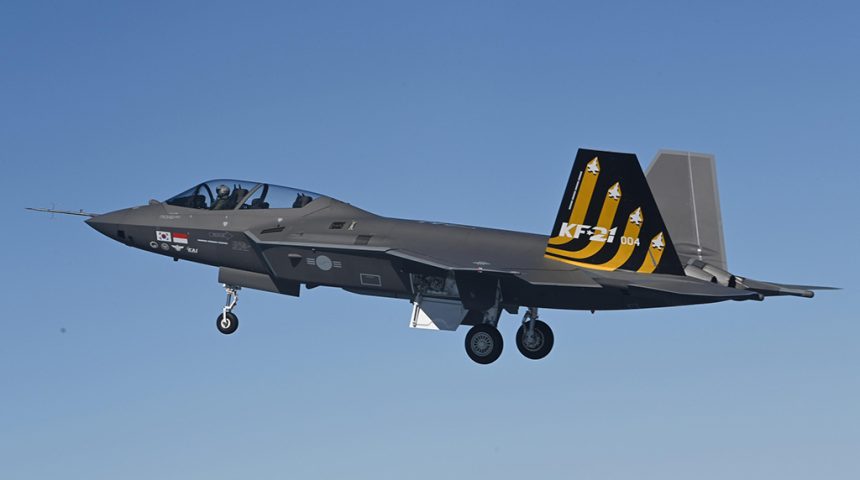South Korea’s domestically developed KF-21 Boramae has achieved a new milestone.
On Feb. 20, 2023, the fourth prototype of the KF-21 Boramae (Korean for “Hawk”), successfully flew from the first time from Sacheon airport, headquarters of Korea Aerospace Industries’ production facilities, some 300 kilometers south of Seoul, South Korea. The aircraft, piloted by Major Jeon Seung-hyeon of the 52 Test Evaluation Group, took off at 11.19AM LT and landed there 34 minutes later.
The aircraft is the first prototype of the two-seat variant of the KF-21, destined to carry out the training and operational conversion of the future pilots assigned to the Boramae flight line. Its main difference is the presence of the rear cockpit that required a modification to the internal fuel tank. Six prototypes, including two twin-seat aircraft, will support the testing campaign that is expected to last until 2026, when full scale production should begin with KF-21 Block I. The other two-seat prototype is going to be the airframe #6.
The first flight of the two-seat KF-21 is interesting for several reasons. First of all, it represents a significant progress in the development of the South Korea’s 5th generation aircraft. Second, it marks the second “stealth” fighter to be designed with a two-seat variant. Indeed, the first one was the Chinese J-20, whose dual seat version broke cover in July 2021. This is what this Author wrote about the Chinese prototype:
With all the previous 5th generation aircraft existing only in the single-seat version, the new two-seater J-20 variant is going to give China several interesting opportunities. The first and most obvious one is that they will have a dual seat version of their frontline fighter that can be used to train the pilots destined to the J-20 fleet. However, considered that the most modern aircraft are much easier to handle than the previous generations ones, the only benefits of a training variant would almost be negligible.
What’s far more important is that the additional crew member can perform tasks like operating some of the on-board sensors or managing a loyal wingman: the proliferation of displays and information coming from multiple sources clashes with the limited cognitive and processing capacity of a human being. Each sensor is as useful as the ability of the pilot to interpret and exploit the details it provides. In practice, no matter how many sensors the aircraft carry, the only effect a constant flow of data being shown on the displays in front of a pilot’s eyes would only be to saturate his or her attention making the large amount of information available simply unusable. With a second brain aboard, this problem is solved (obviously, within certain limits) and the aircraft can undertake additional tasks.
The same applies for the tandem-seat KF-21, whose role could expand in the SEAD/DEAD (Suppression/Destruction of Enemy Air Defenses) mission too.
Generally speaking, the KF-21 is considered a low-cost, less-stealthy alternative to the American F-35. ROKAF (Republic Of Korea Air Force) expects to operate it by the 2030s to replace its fleet of ageing F-4E Phantom and F-5E/F Tiger II aircraft.
The KF-21 is strikingly similar to other 5th generation designs (although it is considered a 4.5 gen. aircraft): in particular, the South Korean jet shares much resemblance with the F-22 Raptor including the similar canted twin tails, general nose section and inlet shaping. The “Boramae” also features a conformal gun above the left air intake, as the F-35A. About 65% of the technology used on the KF-21 is of South Korean origin, including the active electronically scanned array (AESA) radar which is currently being tested aboard a modified Boeing 737-500.
South Korea and Indonesia agreed in 2014 to jointly develop the next generation fighter in a project worth 7.5 trillion won (6.3B US), with Indonesia committed to paying 20% of the total development cost. South Korea is planning to deploy 40 KF-21s by 2028 and a total of 120 by 2032 while 50 should be deployed by Indonesia. For this reason, the prototypes sport the Indonesian flag along with the Korean one during the first flight.









